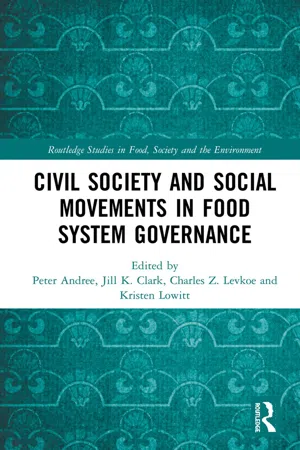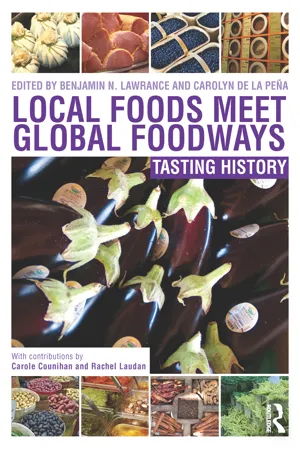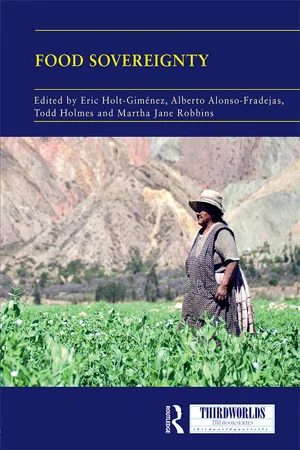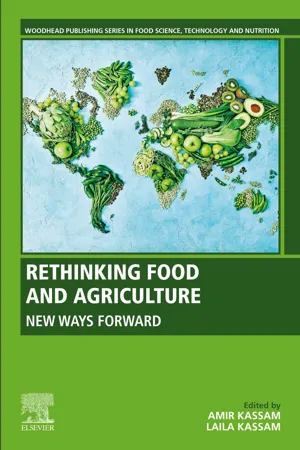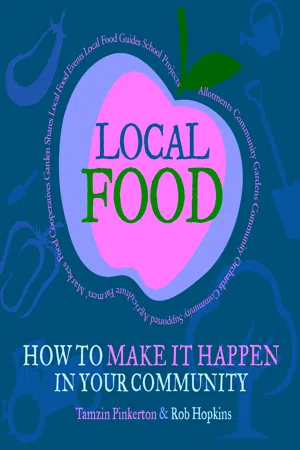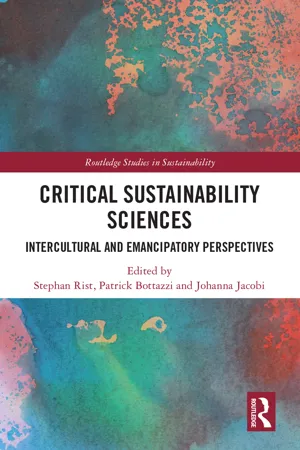Geography
Food Movements
Food movements refer to collective efforts by individuals, organizations, and communities to advocate for changes in the food system. These movements often focus on issues such as sustainable agriculture, food justice, and access to healthy, locally produced food. They aim to address social, economic, and environmental concerns related to food production, distribution, and consumption.
Written by Perlego with AI-assistance
Related key terms
Related key terms
1 of 4
Related key terms
1 of 3
8 Key excerpts on "Food Movements"
- Peter Andrée, Jill K. Clark, Charles Z. Levkoe, Kristen Lowitt, Peter Andrée, Jill K. Clark, Charles Z. Levkoe, Kristen Lowitt(Authors)
- 2019(Publication Date)
- Routledge(Publisher)
These movements seek to reinforce, build on, and scale-up innovative, place-based initiatives. These initiatives consider food as part of an interrelated system that includes not just its quality and health, but also the broader context of how food moves from the fields, water, and forests to our plates and beyond. These movements, and the initiatives they spearhead, are associated with a range of labels including fair trade, civic agriculture, food justice, food sovereignty, food democracy, agroecology, slow food, and community food security (Schiff & Levkoe, 2014; Friedland, 2010; Hendrickson & Heffernan, 2002). We refer to this collection of actors with related objectives as “Food Movements”, in the plural. This appellation recognizes their diversity while acknowledging overlapping and, at times, conflicting goals. 1 One reason to refer to Food Movements collectively is because, as social movements, they are increasingly connected. For example, Levkoe (2015) describes Canada’s food movement as a “network of networks”, highlighting the collaborations across sectors, scales, and places found in contemporary food activism. This connectivity relates to the growing tendency of food movement actors to adopt an integrated, system-wide perspective that seeks to address multiple elements of food systems, including how decisions are made, and by whom. Two examples from different scales illustrate the increasing connectivity, shared analysis, and shared goals of today’s Food Movements. In Canada, the People’s Food Policy (PFP) project launched a ground-breaking report in 2011 that synthesized food system-related concerns and aspirations from a variety of social movements across the country, including activists from farmers’ unions, Indigenous groups, international development organizations, urban food security organizations, labour unions, environmental groups, and others (Levkoe & Sheedy, 2018)- eBook - ePub
Local Foods Meet Global Foodways
Tasting History
- Benjamin Lawrance, Carolyn de la Peña(Authors)
- 2013(Publication Date)
- Routledge(Publisher)
global foodways explores local dynamics of global food and drink production, consumption, and mobility via a trans-locational lens. The chapters address issues of migration, settlement, colonization, imperialism, race and identity, consumption, distribution, governmentality, and globalization. Sites and processes include the transplanting and importation of food crops and animals from one region of the world to another; the hybridization of foodstuffs; the dissemination of technologies of food production; the creation of recipes and beverages for local and global markets; the shift in consumption patterns as echoes of modernity and post-modernity; and the relationship between food, drink, and political change.Here in this anthology, nature and culture converge to create desirable, or undesirable, food and drink. We see this as a logical next step in the expanding domain of food and cuisine studies, the contours of which have recently been articulated by Carole Counihan and Penny Van Esterik. In the second edition of their now-standard reader, they ponder the mushrooming of the sub-field, and in particular how “food has permeated almost every scholarly field and become a widely accepted research topic.” Whereas when they embarked on their careers, food was “marginalized as a scholarly focus,” by the late 2000s, the proliferation in food, drink and cuisine research extends deeply into historical studies, anthropology, geography, ethnic studies, and sociology, and is also making significant inroads into human biology, archaeology, political science and economics.7 - eBook - ePub
Learning, Food, and Sustainability
Sites for Resistance and Change
- Jennifer Sumner, Jennifer Sumner, Jennifer Sumner(Authors)
- 2016(Publication Date)
- Palgrave Macmillan(Publisher)
2014 ), this conflict and intersectionality can be read through the description of four kinds of alternative food system efforts with emphases and attachments to: the biophysical sustainability of food production; life quality for farmers and agrarian communities; food access, quality, and human health; and emancipatory possibilities for socially just food systems.The demand for social justice has informed the direction and strategies of alternative food system movements in recent years. The notion of food justice does not necessarily prescribe clear routes to establish a more just food system; instead, it provides a language and vision to open up pathways for action and advocacy (Gottlieb and Joshi 2010 ). Both academic and grassroots communities are increasingly engaged in food justice work as a means to critique the social, economic, and political hegemony in our food system, calling much needed attention to racial, gendered, and class relationships and intersections in the control over the production and consumption of food (Allen 2010 ; Alkon and Agyeman 2011 ; Guthman 2008 ; Slocum 2007).For the purposes of this chapter, we have chosen to interact with three alternative food movement discourses according to the intended end goals of our narrative project to engage with the generative possibility of stories as sites of learning and knowing. Therefore, it is not our intention to focus on one alternative food movement (e.g., food security) or social movement sector (e.g., sustainable food production); instead, we embrace the intersections of community food systems, community food security, and community food work as fluid concepts and “community-level” discourses, to better embrace the multiplicity of “cultural worker” experiences and their possibilities for change in our food systems. We acknowledge, however, a number of scholars who have more adequately provided a comprehensive explanation of the history of alternative Food Movements (see Allen 2004 ; Constance et al. 2014 ; Goodman et al. 2014 - eBook - ePub
Food Sovereignty
Convergence and Contradictions, Condition and Challenges
- Eric Holt-Gimenez, Alberto Alonso-Fradejas, Todd Holmes, Martha Jane Robbins(Authors)
- 2018(Publication Date)
- Routledge(Publisher)
61Locality and seasonality are cited as responses to features of geographical distancing in the industrial food system and, in this way, localisation is proposed as an oppositional force to distance and durability.62 Local Food Movements tackle the distance between producers and consumers through direct marketing and the social re-embedding of food systems. Hinrichs asks difficult questions about who benefits in these local food transactions, however, and warns that social embeddedness is often taken for granted and generalised, when it should be assessed more vigorously.63 Local Food Movements may heighten distancing through their ‘missionary impulses’, according to Guthman’s scathing critique of local food system practices in the USA as racially marginalising and exclusionary.64 Allen and Wilson suggest that many local food initiatives may reinforce existing inequalities of race and class rather than challenging them, because of the focus on consumer choice that ignores historically constructed inequalities. They posit that food sovereignty and other initiatives centred in the global South are more attuned to the importance of dealing with inequality.65 In contrast, Holt-Gimenez and Shattuck characterise the food justice movements as more concerned with marginalised people and their access to food and question the notion that they are predominantly made up of elites. They portray the food sovereignty movement as more concerned with structural transformation and redistribution of productive resources, often with a class lens, although this is not always clear.66 - eBook - ePub
Rethinking Food and Agriculture
New Ways Forward
- Amir Kassam, Laila Kassam(Authors)
- 2020(Publication Date)
- Woodhead Publishing(Publisher)
17: Social movements in the transformation of food and agriculture systems
Nassim Nobari Seed the Commons, San Francisco, CA, United StatesAbstract
The radical transformation of our food systems is necessary to address the social and environmental crises of our time. This can only be led by grassroots social movements, as the solutions that come from corporate, governmental, and philanthropic actors are false solutions that maintain the status quo. They find legitimacy by misportraying the nature of the problems to be solved and promoting deeply entrenched narratives of lack. This chapter explores these and counters that we already have the solutions to create sustainable, ecological food systems. It advocates for a transition to a food system based on vegan agroecology, where nonhuman animals are included in our circle of moral concern, and speaks of the stirrings of a new movement: the veganic farming movement.Keywords
Animal liberation; Agroecology and social movements; Colonization; Ecological farming; Narrative of lack; Regenerative grazing; Veganic17.1: Introduction
As a young human rights activist, I came to be interested in food systems and land-based struggles as a way to address the root causes of injustice, poverty, and environmental degradation. As I spent time volunteering with peasant activists from around the world, it became increasingly clear that the loss of land, seeds, and sovereignty of which they spoke was a key modern iteration of colonization.The corporate takeover of our food systems is a fundamental mechanism of capitalism: seeds, a hitherto freely exchanged capsule of life, are patented and commodified; farmers are displaced from their land and forced to become wage earners within a globalized food system and other destructive industries; etc. Understanding this, it becomes clear that addressing industrial agriculture is more than an environmental issue. Its effects extend beyond the destruction of local ecosystems because it is intrinsically organized around the dispossession of the many for the profit of the few. - eBook - ePub
Food Systems Governance
Challenges for justice, equality and human rights
- Amanda Kennedy, Jonathan Liljeblad(Authors)
- 2016(Publication Date)
- Routledge(Publisher)
3Food sovereignty Governance and exclusion in an alternative social movement Kristal Jones and John T. EshlemanIntroduction
Critical analysis of the contemporary dominant global food system often focuses on the economic arrangements that structure the system (Busch, 2010; Friedmann, 2005) and the power dynamics among actors that define certain linkages and paths (Bair and Werner, 2011; Gereffi et al., 2005). Questions about the political economy of food and agriculture have long focused on the inequalities inherent in these economic and power dynamics, and these questions have generated social movements to respond to a perceived injustice (for an overview of US agrarian political economy, see Buttel, 2001; for a global review, van der Ploeg, 2008). From fair trade and organic certification (see Busch and Bain, 2004; Guthman, 2004) to an emphasis on producing and buying local food (Hinrichs and Allen, 2008; Goodman and DuPuis, 2002) to a resistance toward genetically modified production systems (Schurman and Munro, 2010), individuals and communities have mobilized to create alternative food production and consumption systems as a way to deal with the negative externalities associated with the dominant global food system. Often termed “alternative agriFood Movements” (AAMs), this range of movements each with their own particularistic goals “together reflect widening disenchantment with conventional corporatized agriculture and food” (Hinrichs and Eshleman, 2014, p. 139, see also Constance et al., 2014).The inequalities and injustices that have sparked AAMs have been framed in a variety of ways, and these frames are then reflected in the institutions that support the alternative systems being created. The specific framing and institutionalization of social movement goals – diagnosing the problem, formulating a solution, and motivating social action – also affect the ultimate impacts of the movements (Benford and Snow 2000). Structural analysis of the role of social movements in generating alternative systems, like those emerging from political economy approaches, can provide a foundation for characterizing ideal and actual governance arrangements among systems (Evans, 2008; Brenner and Theodore, 2002). Holt-Giménez and Shattuck (2011), for example, analyze AAMs through the lens of modern political economy, and argue that the crises generated by the dominant food system have spawned the social movement responses to the dominant system. They pose the theoretical question of whether these social movements can in fact govern and change the dominant global food system, or whether the creation of alternative spaces actually supports the perpetuation of the dominant system with all its inequalities that AAMs are ostensibly mobilized against (see also Fairbairn, 2012). - eBook - ePub
Local Food
How to Make it Happen in Your Community
- Tamzin Pinkerton, Rob Hopkins(Authors)
- 2009(Publication Date)
- Green Books(Publisher)
These efforts are a crucial part of the bigger local food picture, and it is important to remember that decisions made at the strategic and legislative levels have the potential to effect profound, positive change in each stage of the food supply chain, from the planting of a seed to the eating of a meal. But, while multilateral engagement and communication has its place, our main focus here is to revive community action around food; to encourage people from all places and backgrounds to look within themselves to find the solutions, energy and power necessary to stay healthy and fed for generations to come. As this book is being written the local food movement is growing, evolving and taking on new shapes in the communities that nurture it. These communities that are reclaiming their right and ability to make change happen include villages, towns, cities, forests and islands – so, as we shall see, the range of projects emerging from them is just as varied. This book is therefore designed to appeal to community groups of whatever size, shape and location. It is also purposely non-prescriptive or directive, but is simply a tool, providing groups with inspiration and signposts to accompany the creativity, ideas and passion they already have. Steps and tips are suggestions for action that groups can mull over and use as they see fit, and are by no means the only way of doing things. The speed of evolution within the movement means that there are many ideas, models and edible epiphanies besides those listed here that will arise in the future (some perhaps springboarding from this very book) - eBook - ePub
Critical Sustainability Sciences
Intercultural and Emancipatory Perspectives
- Stephan Rist, Patrick Bottazzi, Johanna Jacobi, Stephan Rist, Patrick Bottazzi, Johanna Jacobi(Authors)
- 2023(Publication Date)
- Routledge(Publisher)
Schlosberg 2013 ).Food, politics, and democracy: challenges for a critique of sustainability
This part attempts to insert the movement in Brazil as part of a broad global movement, which questions the current format of dominant food systems and advocates for their radical transformation, driven by the criticism of corporate grabbing of the agenda of the UN Food Systems Summit finalized in September 2021. In other words, the aim is to establish the threads of critical propositions, emerging in the international debate on the necessary transformations of the predominant food systems, in view of sustainability and health; more specifically, we are considering the political paths of the discussions in Brazil and whose interests, visions, narratives of different actors on food, food systems, and sustainability are opposed.As highlighted by Maluf et al. (2022) , the narratives of national and international civil society organizations, as well as national policies and plans built with social participation, emphasize social, environmental, and power issues. It recurs the argument of the need for paradigm shifts in food systems toward the consolidation of agroecological and peasant modes of food production in which social relations, values, and practices should reorient the relationship with the territories and promote climate and environmental justice. Based on a wide range of experiences around the world, the document called “Voices from the Ground” launched by the Civil Society and Indigenous Peoples Mechanism linked to the United Nations Committee on World Food Security (CSM 2020
Index pages curate the most relevant extracts from our library of academic textbooks. They’ve been created using an in-house natural language model (NLM), each adding context and meaning to key research topics.
Explore more topic indexes
Explore more topic indexes
1 of 6
Explore more topic indexes
1 of 4
